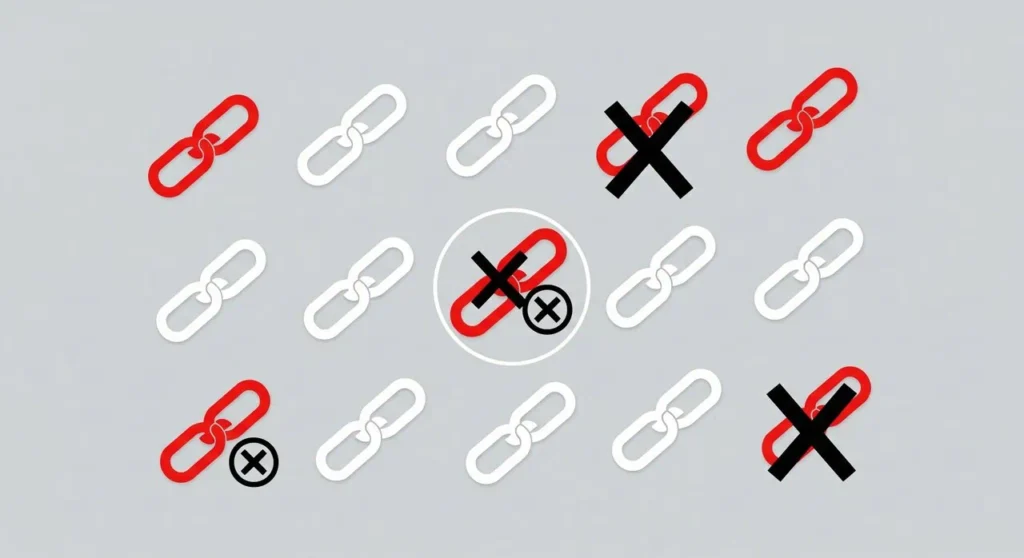What Are Broken External Backlinks
Sometimes another site links to you, but the page they’re sending people to doesn’t exist anymore. Maybe you deleted it, changed the URL, or they just messed up the address. That’s what we call a broken external backlink, a link that goes nowhere.
The problem isn’t just about users hitting a dead page. Those links also stop passing authority to your site. If you know how to fix broken external backlinks, you can turn those wasted connections back into useful ones. A lot of solid link building strategies start with cleaning up what’s already out there.
Why Fixing Them Matters for SEO
White hat link building isn’t only about adding new backlinks. The links you already have are just as important. When one of them breaks, search engines stop passing value through it, and people who click end up on an error page. That’s a wasted opportunity, and it slowly makes your site look less trustworthy.
At Novo, we treat broken backlinks repair as routine SEO work. Restoring a link you’ve already earned often gives quicker results than starting from zero. It’s like patching a leak before it drains more value.
- Lost authority is sent back to your pages;
- Visitors get to the right content instead of hitting 404s;
- Your backlink profile stays clean and reliable.
Novo helps clients bring broken backlinks back to life, so they don’t lose the authority or traffic they’ve already worked for.

Tools to Detect Broken Backlinks
You can’t fix what you don’t see. Hunting down broken backlinks by hand is a nightmare, which is why most people use a mix of software and crawlers to do the heavy lifting. These tools scan your backlink profile, spot the pages that return errors, and give you a list of fixes to work through. Novo’s guide on tier-2 backlink building makes the same point — keeping links alive is just as valuable as building new ones.
- Ahrefs – Great for finding links pointing to 404s. Their “Best by Links” report shows which dead pages once carried the most authority.
- SEMrush – Runs audits automatically and pings you when a link breaks. The notifications save a ton of time.
- Screaming Frog – A crawler you install on your computer. It’s fast, scalable, and especially useful if you’re running checks across a large site.
- Google Search Console – Free and simple. It won’t catch everything, but if Google sees a missing page, you’ll know.
- Majestic – Known for its Trust Flow metric, but also good for spotting when a backlink disappears or goes bad.
- Dead Link Checker – A free web-based crawler. Just enter your domain, and it scans for dead links across multiple pages in one go.
- SEO SpyGlass (LinkAssistant) – Offers a free version that tracks backlinks, detects broken ones, and shows which links still pass authority. Useful for combining backlink data with error monitoring.
- Integrity (Mac) – A free tool for macOS that works like Xenu, scanning all site pages and highlighting broken internal and external links.
- Dr. Link Check – Cloud-based and free for small scans (up to 1,500 links). It emails you when issues are found, making it useful for quick checks.
- Broken Link Checker plugins – Lightweight add-ons (for WordPress or Chrome) that flag outbound links gone wrong.
Most pros don’t stick to just one tool. Using something like Ahrefs or SEMrush for the data, and pairing it with Screaming Frog for crawling, usually gives the clearest picture. That mix lets you catch problems early and keep your link profile in shape without drowning in manual checks.
Methods to Restore or Redirect Links
After spotting which backlinks are broken, the next step is to decide how to bring their value back. There’s rarely a single fix that works for everything, the right choice depends on why the link failed in the first place. Search Engine Journal suggests a user-focused approach — prioritize fixing broken backlinks that genuinely support user experience, not every single one.
Teams that manage SEO at scale know this process inside out, because repairing links can often bring quicker wins than building new ones. It’s the type of routine that makes fix broken links SEO a constant part of long-term site health.
- 301 redirects – If you move or rename a page, send the old URL to the new one. Visitors won’t notice, and the link value keeps flowing.
- Bring back deleted pages – Sometimes you kill a page that still has backlinks. Put it back, even a slimmed-down version, so the links don’t die.
- Ask for fixes – If another site messed up the link with a typo or old URL, just reach out. A quick email usually gets it fixed.
- Use a similar page – When the original page is gone forever, point the link to the closest match you’ve got. Better than a 404.
- Merge content – If several broken links all point to similar stuff, make one solid page and redirect them there. Stronger and simpler.
In practice, experienced link-building teams don’t just “fix” a link, they choose the option that protects the site’s authority and keeps future outreach clean. As Neil Patel explains, broken link building flips the script — you offer to fix a broken link first with your replacement content, then politely ask for inclusion — increasing your pitch’s success.
Our work with link building outreach also shows, link repair blends technical SEO with relationship management, making it a crucial part of sustainable growth.

Preventing External Link Issues
Fixing broken backlinks is fine, but it’s better if they don’t break at all. Most external link errors are boring little things: someone deletes a page, you rename a URL, or the site you linked to just disappears one day. You can’t stop all of it, but you can avoid a lot with some simple habits. Novo’s blog on link building keeps coming back to this idea: prevent problems first, clean up less later.
- Don’t delete pages blind. If a URL has backlinks, keep it or redirect it.
- Run crawls now and then. Once a month if you’re big, every quarter if you’re not.
- Move content? Point the old link somewhere that still makes sense.
- Outbound links rot too. Click them once in a while and see if they still work.
- Built links through outreach? Stay in touch. A quick ask usually gets them updated.
- Set up 404 alerts. Use GA4 events, Search Console, or SEO tools with email notifications to track when users or backlinks hit missing pages. This way, you know the moment a link breaks, instead of waiting weeks for a crawl.
You’ll never have a perfect record, but with a routine like this, broken links stay small problems instead of big clean-ups.
Every site runs into broken backlinks sooner or later — pages get deleted, URLs change, or a linking site makes a mistake. If you don’t deal with them, you lose both traffic and authority. The good news is the fixes are straightforward: redirects, content restores, or quick update requests. Prevention helps even more, regular crawls and smart redirects keep problems small. At Novo, this mindset shapes our work, and it’s something we share often through our link building insights, showing how to keep links alive so they keep delivering value.
